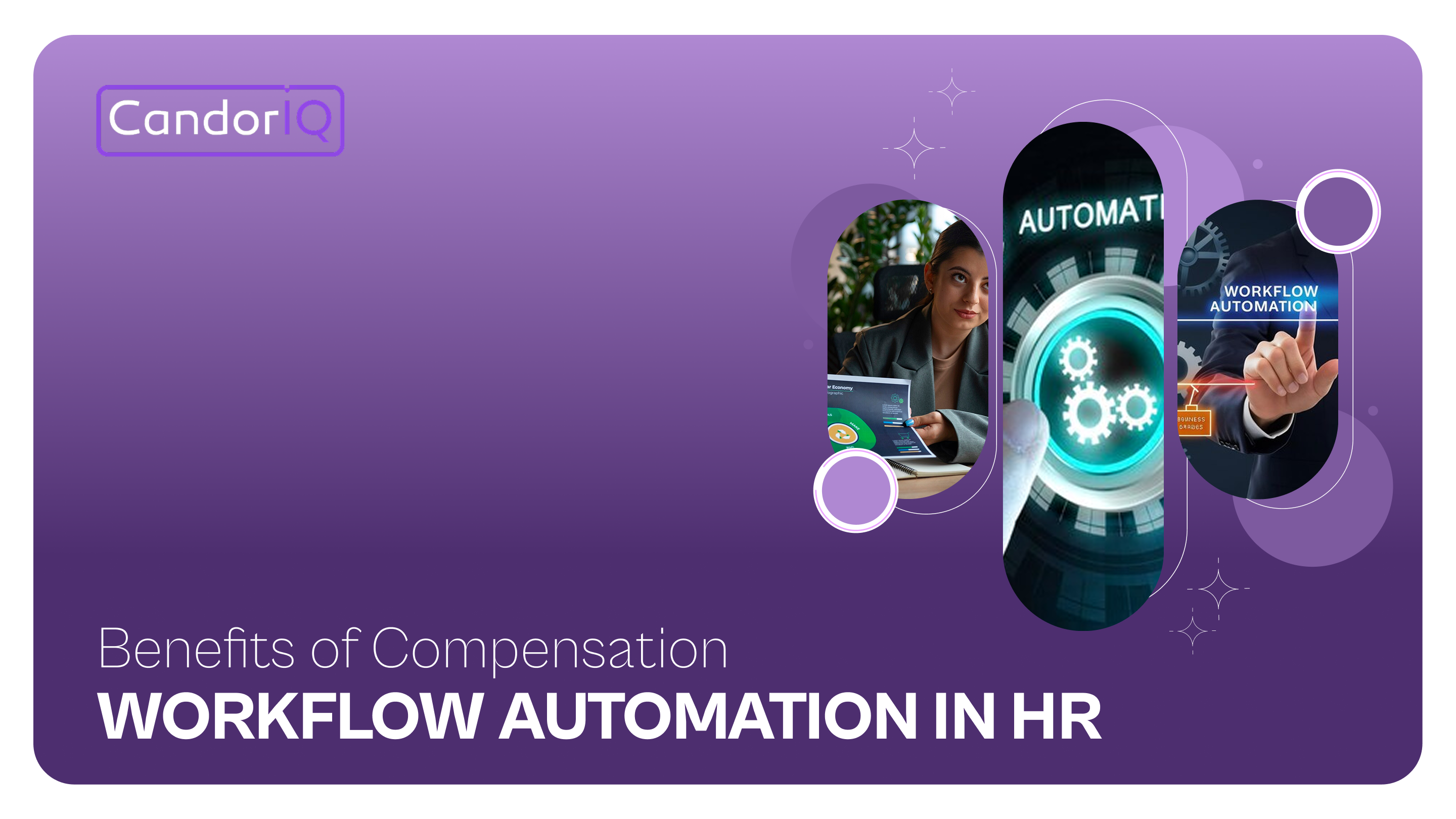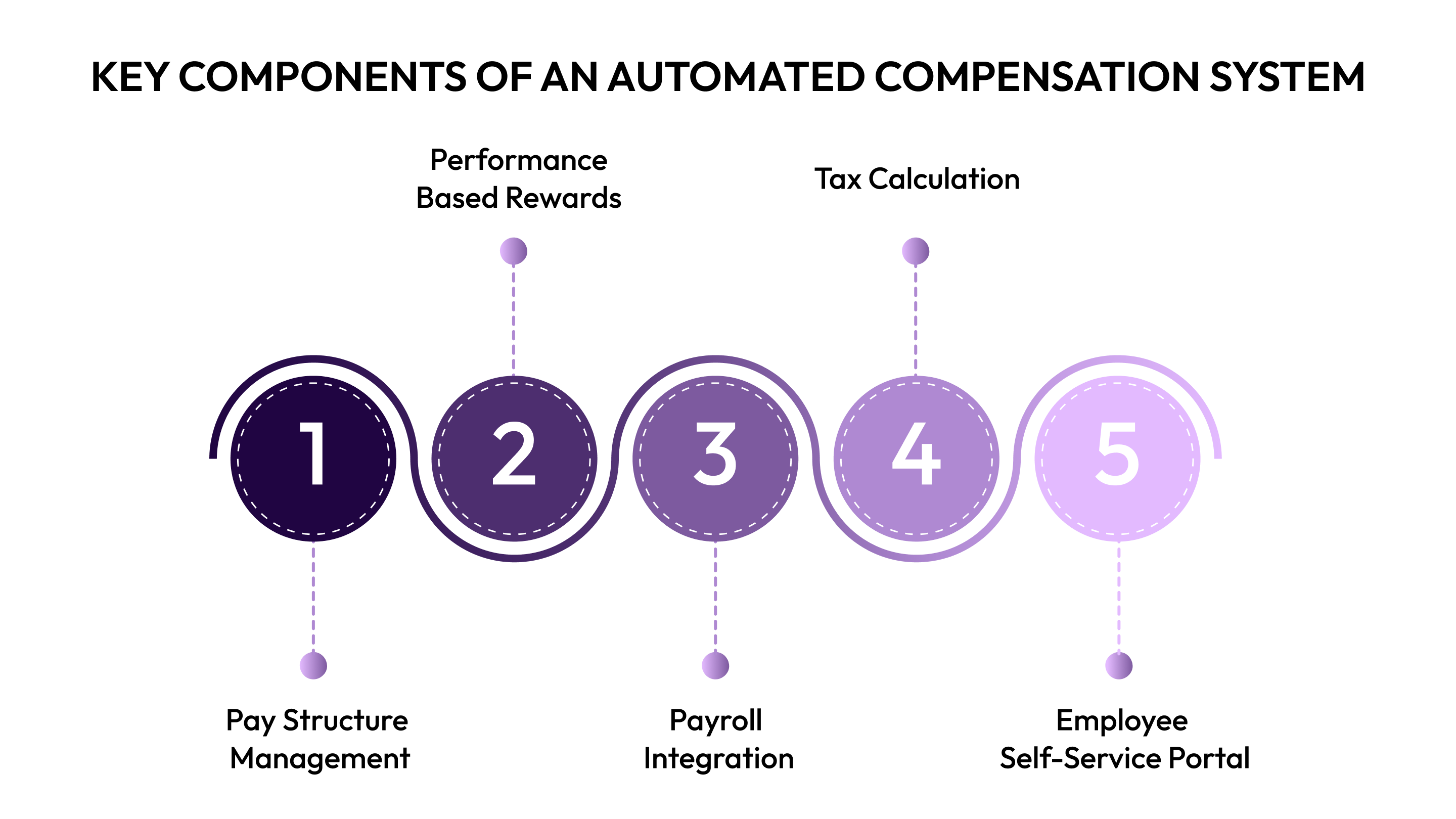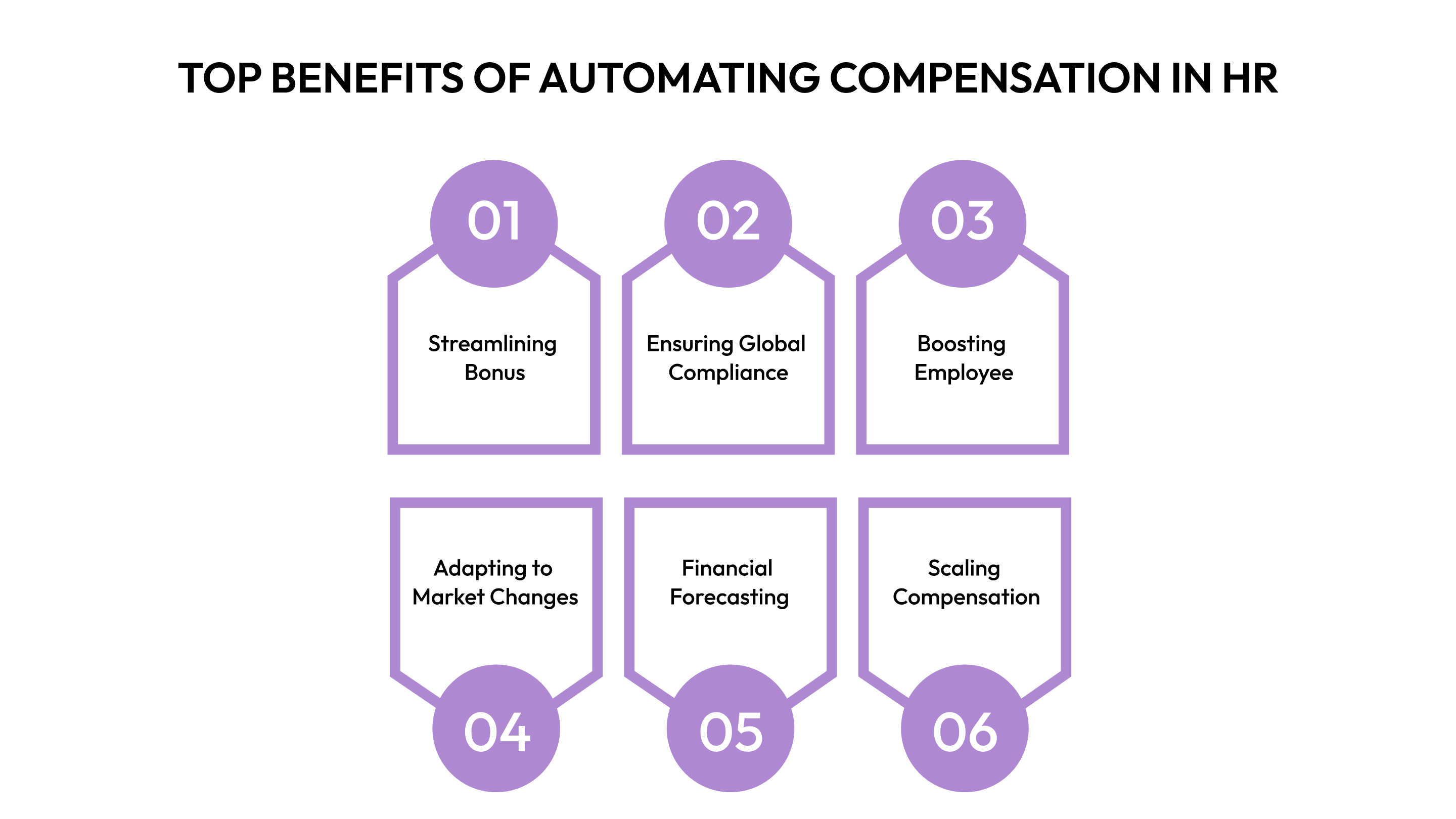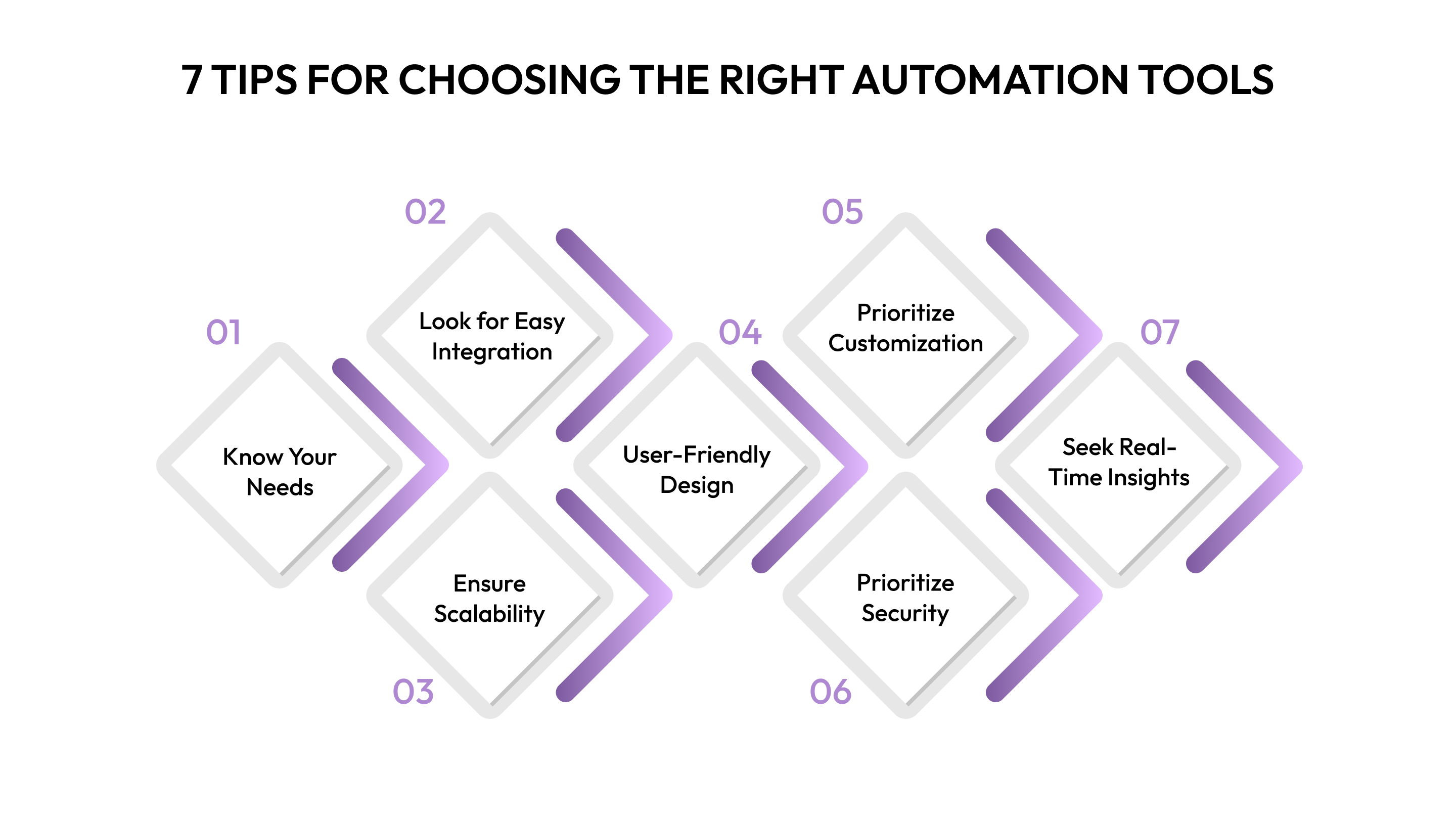Benefits of Compensation Workflow Automation in HR
Discover how compensation workflow automation enhances HR efficiency, reduces errors, and ensures timely, accurate pay management for better employee satisfaction.

When your company’s headcount doubles in a year, compensation chaos can quickly set in. Misplaced spreadsheets, missed approvals, and delayed payouts become all too common. Therefore, for fast-scaling organizations with lean HR and finance teams, compensation workflow automation isn’t just an upgrade; it’s the smarter, simpler way to work.
In fact, AI and automation have the potential to take over more than half (52%) of the tasks typically handled by a rewards team. It helps streamline reviews, approvals, and pay adjustments across regions, ensuring every decision is accurate, transparent, and fair.
This blog breaks down how automation can turn compensation management from an administrative burden into a real driver of growth.
At a glance
- Manual compensation management doesn't scale. Automation does, keeping your team happy, your data accurate, and your HR focused on people, not paperwork.
- The payoff is real. Cut bonus processing time by 80%, stay compliant across every region, give employees instant access to their pay details, and actually trust your financial forecasts.
- What makes it work? Smart pay structures, automated performance rewards, seamless payroll sync, built-in tax compliance, and self-service portals that answer employee questions before they're even asked.
- Ready to automate? Start by pinpointing what's breaking in your current system, pick tools like CandorIQ that scale with growth, train your team on the basics, and keep optimizing as you go.
What Is Compensation Workflow Automation?
Compensation workflow automation uses technology to take over repetitive tasks, ensuring accuracy and saving you time. Instead of manually calculating pay or using spreadsheets, automation handles everything in real-time. It reduces errors and ensures timely payments.
How It Works
Compensation workflow automation systems integrate with your existing HR and financial software to handle tasks like:
- Salary calculations
- Bonus distributions
- Incentive tracking
- Tax deductions
Once set up, the system operates automatically, calculating pay, managing deductions, and applying bonuses according to established rules. For instance, if an employee hits a performance target, the system automatically adjusts their pay and bonus without any manual input from HR.
Want to dive deeper into building a solid foundation? Check out how to design an effective employee compensation plan that aligns with your business goals.
However, to get the most out of compensation workflow automation, it's important to understand the key components that make the system work.
Key Components of an Automated Compensation System

The key components are the building blocks that drive efficiency, reduce errors, and ensure everything runs smoothly. Here’s a quick breakdown:
- Salary and Pay Structure Management: An automated system makes setting up and adjusting pay structures a breeze. It ensures employees are paid accurately based on their role, location, and other criteria, so you can avoid any confusion or mistakes.
- Performance-Based Rewards and Incentives: Tracking bonuses and incentives can be tricky. Automation takes care of it by linking employee performance to predefined reward structures. This ensures bonuses are calculated correctly every time, no manual work needed.
- Payroll Integration: An automated compensation system like CandorIQ integrates directly with your payroll system, so calculations are done automatically. This cuts down on the time spent processing payroll and reduces errors, ensuring employees are paid accurately and on time.
- Tax Calculation and Compliance: Tax laws change frequently, and keeping track of them manually can lead to mistakes. Automation handles the calculations for you, ensuring that deductions are accurate and that you remain compliant with current tax regulations.
- Employee Self-Service Portal: Automation gives employees access to their compensation details through an easy-to-use portal. They can view their salary, bonuses, and benefits in real time, reducing the number of questions HR needs to answer and promoting transparency.
Now that you know what makes an automated system tick, let's talk about the real impact it has on your HR operations.
Top Benefits of Automating Compensation in HR

As companies grow, managing compensation becomes more complex and time-consuming. Compensation workflow automation simplifies the process, boosting efficiency, accuracy, and strategic alignment.
Here’s how automation makes a difference:
Streamlining Bonus Processing
If your HR team is still manually processing bonuses, you know how time-consuming and error-prone it can be. You can find yourself spending hours each quarter on bonus calculations, leading to delays and occasional mistakes.
By automating the process, you can reduce processing time by at least 80%. Now, your HR team can focus on more important tasks, like employee engagement and talent management, while employees get their bonuses on time, every time.
Ensuring Global Compliance
Managing compensation across different regions with varying tax laws and regulations can be a nightmare. If you are a multinational company, you have likely experienced this firsthand, constantly running into discrepancies and compliance issues.
However, by automating your compensation workflows, you ensure real-time pay adjustments that comply with local tax rules and regulations. This automation helped you avoid compliance penalties and ensured employees were paid correctly according to their local laws.
Boosting Employee Engagement with Transparency
Want to boost employee engagement? Start with transparency. If you have noticed that your employees frequently have questions about their pay, bonuses, and benefits, it creates a heavy workload for HR.
By implementing an automated compensation system, you can give your employees self-service access to their compensation details, including salary breakdowns and bonus progress. This move reduces HR inquiries and significantly improves employee satisfaction.
Adapting to Market Changes
Amidst the shifting demands of the modern talent market, you need to make quick, informed decisions about compensation. By automating compensation tracking and analysis, you can gain real-time insights into salary trends and employee performance.
With this data, CPOs can quickly adjust compensation structures, offering competitive salaries and retaining top talent, part of a broader shift toward AI-driven HR automation.
Improving Financial Forecasting and Budgeting
If you’re managing compensation in a fast-growing company, you know the difficulty of accurately forecasting payroll expenses. HR and finance teams often struggle to align compensation costs with the company’s overall budget.
You can solve this by integrating a compensation and payband builder, such as CandorIQ, with financial planning tools. Now, they track payroll expenses in real time and forecast future costs with greater accuracy, making budgeting smoother and more reliable.
Scaling Compensation with Growth
As companies expand globally, managing compensation across regions and pay structures becomes overwhelming. KRAFTON Americas faced this challenge head-on—fragmented data and manual processes couldn't keep up with their rapid growth.
By automating their compensation workflows, they gained real-time visibility, eliminated manual bottlenecks, and built a system that scales seamlessly. The takeaway? Automation adapts to new regions, pay bands, and team sizes without adding HR headcount.
Ready to make the switch? Here's how to transition effectively.
Steps to Transition from Manual to Automated Systems

Switching from manual compensation management to automation can seem like a big step, but it doesn’t have to be overwhelming. With the right approach, you can make a smooth and quick transition.
Here’s a step-by-step process on how you should do it:
Step 1. Assess Your Current System
Start by identifying pain points and areas for improvement in your current system to prioritize automation.
Step 2. Select the Right Automation Tool
Look for a solution like CandorIQ that fits your needs, integrates with existing systems, and scales as you grow. Ensure your data mapping strategy is solid first. Clean data is essential for successful automation.
Step 3. Plan Your Implementation
Create a clear, step-by-step implementation plan. Define timelines, assign responsibilities, and involve key stakeholders like HR, IT, and finance.
Step 4. Train Your Team
Your HR team will need to understand how the new system works, even though automation will do most of the heavy lifting. Provide training on the system’s features, exception handling, and employee self-service portals. A well-trained team will make the transition much easier.
Step 5. Communicate the Change to Employees
Transparency is key when introducing new systems. Let employees know what to expect and how the transition will benefit them. Clear communication helps build trust and reduces resistance to change.
Step 6. Monitor and Optimize
Once the system is live, track the system’s performance, gather feedback, and make adjustments as needed to ensure ongoing efficiency.
Following these steps sets you up for success, but picking the right tool makes all the difference.
7 Tips for Choosing the Right Automation Tools

The right platform saves time, boosts efficiency, and ensures accuracy, but with so many options out there, how do you know which one fits your needs? Follow these tips to pick the best automation tool for your organization.
- Know Your Needs: Start by defining exactly what you need. Do you require payroll management, performance-based bonuses, or compliance tracking? And then focus on tools that meet those needs.
- Look for Easy Integration: The last thing you want is a tool that doesn’t sync with your current HR, payroll, or financial systems. Choose a tool that integrates seamlessly with the software you already use. This will save you time and avoid the headache of managing multiple disconnected platforms.
- Ensure Scalability: Your business will evolve, and your tools should keep pace. Pick an automation platform like CandorIQ that grows with you, handling new employees, changing compensation structures, and expanding regions without breaking a sweat.
- Opt for User-Friendly Design: Complex tools can slow you down. Look for a platform that’s intuitive and easy for your HR team to navigate. A user-friendly design reduces the learning curve and helps your team get the most out of the system from day one.
- Prioritize Customization: While standard solutions may work, find a tool that allows for flexibility. The more customizable the tool, the better it will serve your specific compensation management goals.
- Prioritize Security and Compliance: Your compensation data is sensitive, so make sure the tool follows industry-standard security protocols. Look for features like encryption, data access control, and regular security audits. Compliance with local and international laws (like GDPR) is also a must.
- Seek Real-Time Insights: Having real-time reporting and analytics can transform decision-making. Choose a platform that offers clear, actionable insights into compensation trends, pay equity, and employee performance. This allows you to adjust strategies quickly and stay competitive.
With the right tool in hand and a clear implementation plan, you're ready to transform how your organization handles compensation.
Final Words
Compensation workflow automation transforms how HR teams manage pay, bonuses, and compliance, turning hours of manual work into minutes of streamlined processes. As your company scales, automation ensures accuracy, maintains global compliance, and gives employees the transparency they deserve.
If you're ready to move beyond spreadsheets and manual calculations, CandorIQ can help you get there. Whether you're managing a team of 50 or 5,000 across multiple regions, see how the right system can simplify your compensation management.
.png)
Book a demo to explore how automation fits your unique needs.
Frequently Asked Questions
Q: How long does it take to implement compensation workflow automation?
Most organizations can go live within 4-8 weeks, including setup, data migration, integrations, and team training. Smaller companies often move faster, while larger enterprises with multiple regions may need additional time.
Q: Will automation replace my HR team?
No. Automation handles repetitive tasks like calculations and data entry, freeing your HR team to focus on strategy, talent development, and employee engagement. It enhances their work, not replaces it.
Q: What happens if the system makes an error?
Quality platforms include validation checks and audit trails that catch discrepancies before payroll runs. You'll have override capabilities for exceptions, plus support teams to resolve issues quickly.
Q: Can automation work for small businesses, or is it only for large enterprises?
Automation benefits all company sizes. Small businesses often gain the most by preventing growth-related chaos early. Many platforms offer scalable pricing so you pay for what you need now and expand later.


